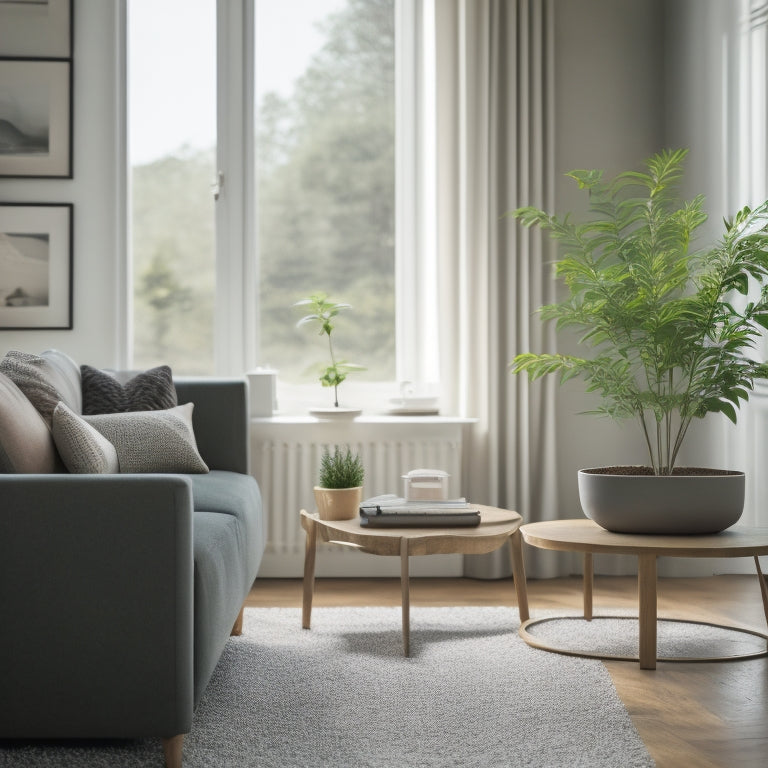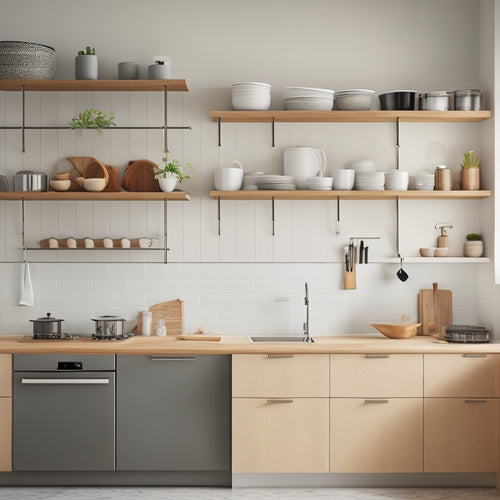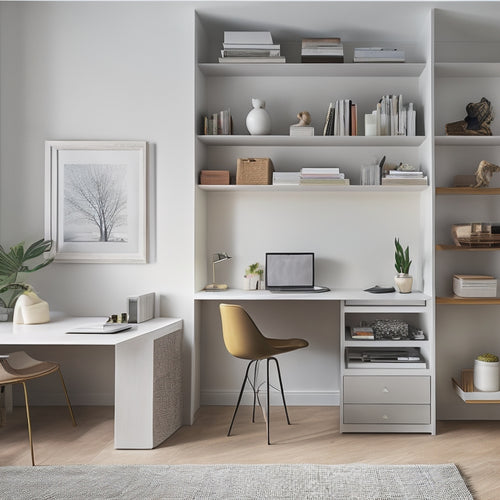
Streamline Your Move: Decluttering Tips for New Homes
Share
You're about to start fresh in your new home, and that means wiping the slate clean of clutter and chaos. Begin by clearing out everything from the new space to create a true blank canvas. Then, purge unwanted items, separating them into keep, donate/sell, and discard piles. Sort and categorize belongings, grouping similar items together, and consider room assignments for each. Let go of duplicate items, and use a 'maybe' box for undecided ones. As you unpack, prioritize essentials like an overnight bag and a 'first night' box. Designate a 'landing strip' for daily essentials, and get ready to discover more tips to optimize your new space.
Key Takeaways
• Start with a fresh slate by clearing out everything from the new space to create a true blank canvas for decluttering and re-evaluation.
• Purge unwanted items first by letting go of clutter accumulated over time and identifying essential items needed or loved.
• Sort and categorize belongings by grouping similar items together, considering room assignments, and using color coding to differentiate categories.
• Prioritize essential items for functionality and comfort by being ruthless in letting go of broken or outdated items and adopting a 'one in, one out' policy.
• Designate a 'landing strip' near the front door or countertop to create an organized entry station for daily essentials like keys, wallets, and bags.
Start With a Fresh Slate
Clear out everything from your new space, including any leftover materials from the construction or renovation process, to create a true blank canvas for your decluttering and organizing efforts. This is your chance to start fresh, and you don't want any clutter or debris holding you back. Take this opportunity to wipe the slate clean and begin with a fresh start. You're not just moving into a new home, you're creating a new chapter in your life, and it's crucial to start with a clean slate.
Think of this process as a fresh beginning, a chance to re-evaluate your belongings and your habits. You're not just decluttering your space; you're also decluttering your mind. A clean canvas is vital for a successful organizing project. By removing all the clutter, you'll be able to focus on what you truly need and want in your new space.
You'll be able to visualize your ideal layout, and create a system that works for you. So, take a deep breath, roll up your sleeves, and get ready to start with a fresh slate.
Purge Unwanted Items First
When getting ready to declutter your new home, it's crucial to purge unwanted items first.
You'll need to let go of clutter that's accumulated over time, and identify the essential items you truly need or love.
Start With a Clean Slate
You'll save yourself a ton of time and energy by purging unwanted items before you even start unpacking in your new home. This is your chance for a fresh beginning, a blank canvas to create the space you've always wanted. By getting rid of items you no longer need or love, you'll avoid cluttering up your new space and make the unpacking process much smoother.
Take some time to go through your belongings and separate them into three piles: keep, donate/sell, and throw away. Be honest with yourself about each item – when was the last time you used it? Do you still love it? Does it have sentimental value? Don't hold onto items out of guilt or obligation.
Let Go of Clutter
Sort through every item you own, and be ruthless about letting go of anything that's broken, outdated, or no longer serves a purpose in your life. This is the perfect opportunity to break free from emotional attachment to items that are holding you back. Be honest with yourself – if you haven't used it in the past year, you probably won't miss it.
As you sort, remember that clutter shame is a real thing. Don't beat yourself up over the amount of stuff you've accumulated. Instead, focus on the progress you're making and the fresh start you're giving yourself.
Create three piles: keep, donate/sell, and discard. Be brutal about what makes it into the 'keep' pile. If you're unsure, ask yourself if the item brings you joy or serves a practical purpose.
Letting go of clutter can be liberating. You'll feel a weight lift off your shoulders as you get rid of items that no longer serve you. Remember, the goal is to create a streamlined, organized space that reflects the life you want to lead.
Identify Essential Items
Now that you've purged your unwanted items, it's time to identify the must-haves that'll make your new home functional and comfortable. This is where you prioritize the essential items that align with your personal priorities and core needs.
| Category | Essential Items |
|---|---|
| Kitchen | Pots, pans, utensils, and dishes for daily meals |
| Bedroom | Bed frame, mattress, and essential clothing |
| Living Room | Sofa, TV, and lamps for relaxation |
Focus on the items that will make your daily life easier and more enjoyable. Ask yourself, "What do I need to feel at home?" or "What are the things I use daily?" Be honest with yourself, and don't feel guilty about keeping items that bring you joy or serve a purpose. Remember, this is about creating a space that reflects your personal style and meets your core needs. By identifying these essential items, you'll create a sense of comfort and functionality in your new home.
Sort and Categorize Belongings
Take everything out of boxes and off shelves, and group similar items together, like all kitchen gadgets or all cleaning supplies, to get a clear picture of what you have. This is the first step in sorting and categorizing your belongings.
As you group items, consider room assignments and think about which items will go in each room. You can use color coding to differentiate between categories, such as using blue stickers for bedroom items and green stickers for kitchen items.
Here are some tips to keep in mind as you sort and categorize:
- Create categories for items you use daily, such as toiletries or office supplies
- Group items by frequency of use, separating essentials from occasional items
- Consider the layout of your new home and how you'll use each room
- Set aside items that require special care, like fragile decorations or important documents
- Make a 'maybe' box for items you're unsure about keeping or donating
Let Go of Duplicate Items
As you survey your categorized belongings, identify duplicate items that serve the same purpose, and consider letting go of the excess to free up space and reduce clutter. Be honest with yourself - do you really need three identical coffee mugs or five similar t-shirts? By letting go of duplicates, you'll create a more streamlined living space and reduce decision fatigue.
Consider implementing a 'one in, one out' policy to maintain a balanced level of possessions. You can also explore shared storage options with friends or family members who may have similar items. For instance, if you have a duplicate power tool, consider lending it to a friend in exchange for storing theirs.
Another option is to organize item swaps with friends or neighbors. This way, you'll get rid of unwanted duplicates and acquire something you need or want. By letting go of duplicate items, you'll not only declutter your space but also foster a sense of community and cooperation.
Consider a "Maybe" Box
When decluttering, you'll likely come across items that are difficult to categorize as 'keep' or 'donate.' To avoid decision fatigue, consider setting up a 'maybe' box where you can temporarily store these items.
This box will serve as a holding space for items you're unsure about, allowing you to reassess them later with a fresh perspective.
Box for Undecided Items
Set aside a box specifically for items you're unsure about keeping or letting go of, allowing you to revisit these undecided items later. This 'maybe' box is a great storage solution for undecided treasures that you're not ready to part with just yet.
By putting them in a separate box, you can focus on packing and decluttering the rest of your belongings without getting bogged down by uncertainty.
Some common items that may end up in your 'maybe' box include:
- Old photos or mementos that hold sentimental value
- Clothing that's still in good condition but no longer fits
- Kitchen gadgets or appliances that you haven't used in a while
- Books or CDs that you might read or listen to again someday
- Decorative items that no longer fit your style or decor
Items to Reassess Later
Now that you've got your 'maybe' box in place, it's time to fill it with items that you're not ready to make a decision on just yet. This box is perfect for sentimental trinkets, seasonal decorations, or anything else that holds emotional value or serves a purpose only during specific times of the year. Be honest with yourself - if you're unsure about an item, it's better to err on the side of caution and put it in the 'maybe' box.
As you're decluttering, ask yourself questions like 'When was the last time I used this?' or 'Does it still bring me joy?' If you can't answer these questions confidently, it's likely the item belongs in the 'maybe' box.
Don't worry, you're not committing to keeping it forever - you're simply giving yourself time to reassess its importance later. Set a deadline, like six months or a year, to revisit the items in your 'maybe' box and make a final decision about what to keep and what to let go of.
Pack an Overnight Bag
Pack an overnight bag with essentials like a change of clothes, toiletries, and medications to avoid scrambling for these must-haves on moving day. This will save you time and energy when you're trying to settle into your new home.
Think of it as a travel essentials kit, but instead of being for a trip, it's for your first night in your new place.
Here are some items to include in your overnight bag:
- A change of clothes for the next day
- Toiletries like toothbrush, toothpaste, and any necessary medications
- A phone charger and portable charger for extra juice
- A hairbrush or comb and any necessary hair products
- A small makeup bag with essentials like mascara and lip balm
Create a "First Night" Box
Create a 'first night' box containing essentials like toilet paper, towels, and a shower curtain to guarantee you have what you need to get settled in quickly and comfortably. This box will be your lifesaver on moving day, when you're exhausted and just want to unwind.
Pack essential toiletries like toothbrushes, toothpaste, and any necessary medications, so you can stick to your morning routine without a hitch. Don't forget to include a change of clothes, bedding, and a phone charger. Having these basics within reach will save you time and energy, allowing you to focus on getting settled in.
By prioritizing the must-haves, you'll be able to relax and enjoy your new space sooner. As you unpack, remember to put the 'first night' box in an easily accessible spot, like the bathroom or bedroom, so everything is at your fingertips.
With this box, you'll be well on your way to a smooth adjustment into your new home.
Designate a "Landing Strip"
Designate a specific area, like a spot near the front door or a section of countertop, as a 'landing strip' where everyone can place their belongings, such as keys, wallets, and bags, to keep clutter at bay and make it easier to find what you need. This designated spot will become an essential part of your daily routine, serving as a central hub for your daily essentials.
By designating a 'landing strip', you'll create an organized Entry Station that sets the tone for a clutter-free home. This will especially come in handy during your Morning Routine, when you're rushing to get out the door.
Here are some benefits of having a 'landing strip':
- Reduces clutter and mess
- Saves time searching for misplaced items
- Encourages a sense of organization and routine
- Provides a designated spot for important items
- Helps create a sense of calm and control in your new home
Frequently Asked Questions
How Do I Decide What to Keep and What to Donate or Sell?
As you stand in front of your packed boxes, ask yourself: "When was the last time I used this?" and "Do I truly need it?" Adopt a minimalist mindset, prioritize items, and use strategies like the one-touch rule to decide what to keep, donate, or sell.
Can I Declutter and Pack at the Same Time, or Separately?
You can declutter and pack simultaneously, but it's often more efficient to separate the tasks. Develop a packing strategy that allows you to focus on one task at a time, saving you time and energy in the long run.
What if I'm Attached to Sentimental Items and Can't Let Go?
"You're not a hoarder, you're just a sentimental superstar! Create a Memory Box for cherished items, and as you fill it, focus on the Emotional Release that comes with letting go – it's liberating, not losing."
How Do I Involve My Family in the Decluttering and Moving Process?
You involve your family in decluttering and moving by holding regular Family Meetings to discuss goals and tasks, fostering a teamwork approach where everyone contributes, and assigning responsibilities to make the process more manageable.
What Are Some Eco-Friendly Ways to Get Rid of Unwanted Items?
"You'll be amazed at how many unwanted items you can repurpose! Consider upcycling old furniture into unique pieces or donating gently used items to local charities. Then, responsibly dispose of remaining waste through local recycling programs."
Related Posts
-

Tiny Kitchen Big Storage: Space-Saving Ideas
You can transform even the smallest of kitchens into a haven of functionality and style by utilizing every inch of av...
-

7 Essential Strategies for More Storage Space
Take back control of your space by implementing these 7 essential strategies for more storage space. Start by maximiz...

